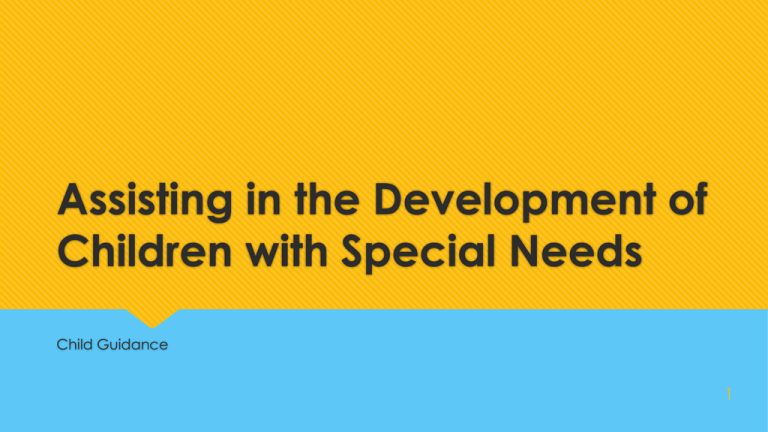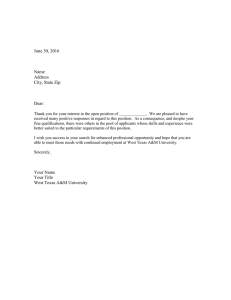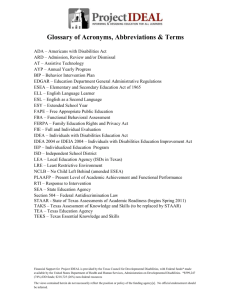
Assisting in the Development of
Children with Special Needs
Child Guidance
1
Copyright
Copyright and Terms of Service
Copyright © Texas Education Agency, 2015. These materials are copyrighted © and trademarked ™ as the property of the
Texas Education Agency (TEA) and may not be reproduced without the express written permission of TEA, except under
the following conditions:
1) Texas public school districts, charter schools, and Education Service Centers may reproduce and use copies of the
Materials and Related Materials for the districts’ and schools’ educational use without obtaining permission from TEA.
2) Residents of the state of Texas may reproduce and use copies of the Materials and Related Materials for individual
personal use only, without obtaining written permission of TEA.
3) Any portion reproduced must be reproduced in its entirety and remain unedited, unaltered and unchanged in any way.
4) No monetary charge can be made for the reproduced materials or any document containing them; however, a
reasonable charge to cover only the cost of reproduction and distribution may be charged.
Private entities or persons located in Texas that are not Texas public school districts, Texas Education Service Centers, or
Texas charter schools or any entity, whether public or private, educational or non-educational, located outside the state
of Texas MUST obtain written approval from TEA and will be required to enter into a license agreement that may involve
the payment of a licensing fee or a royalty.
Contact TEA Copyrights with any questions you may have.
Copyright © Texas Education Agency, 2015. All rights reserved.
2
Children with Special Needs
developmental
disabilities
emotional problems
giftedness
physical disabilities
Copyright © Texas Education Agency, 2015. All rights reserved.
3
Understanding Special Needs
Heredity and environment:
Hereditary factors include the
genetic history and make-up of a
person
Environmental factors affect the
fetus after conception or after child
birth
4
Copyright © Texas Education Agency, 2015. All rights reserved.
The Nature of Special Needs
A disability is any condition that prevents,
delays or interferes with a child’s normal
achievement and development.
Developmental
Learning
Physical
Sensory
5
Copyright © Texas Education Agency, 2015. All rights reserved.
Developmental Disabilities
Some goals for the care and
education of children with
developmental disabilities are as
follows:
o Expanding language skills
o Increasing attention span
o Learning self-help skills
o Mastering basic concepts
6
Copyright © Texas Education Agency, 2015. All rights reserved.
Learning Disabilities
A learning disability involves a
disorder in understanding or
using spoken or written
language.
A child with a learning disability
may be unable to listen, think,
speak, spell or calculate
mathematical problems.
7
Copyright © Texas Education Agency, 2015. All rights reserved.
Dyslexia – A Learning Disability
(click on picture)
Copyright © Texas Education Agency, 2015. All rights reserved.
8
Strategies for Working with Learning
Disabled Children
The following strategies are
suggestions for working with
learning-disabled children:
o behavior modification
o multi-sensory training
o task analysis
9
Copyright © Texas Education Agency, 2015. All rights reserved.
Physical Disabilities
Physical disabilities limit
physical movement or
result in chronic health
problems.
Since children learn
through physical activity,
physical limitations may
affect other areas of
development.
10
Copyright © Texas Education Agency, 2015. All rights reserved.
Physical Disabilities
Learn as much as you can about each
child’s special issues.
11
Copyright © Texas Education Agency, 2015. All rights reserved.
Sensory Disabilities
Vision and hearing problems fall
into the category of sensory
disabilities.
Loss or impaired use of a sense
greatly affects a child’s life and
learning abilities.
With good support and
education, children can
overcome their disabilities and
live normal lives.
12
Copyright © Texas Education Agency, 2015. All rights reserved.
Sensory Disabilities
Caregivers who work with visually impaired children can
aid their development in the following ways:
o Encourage children to make full use of any remaining
vision.
o Help children develop other senses fully.
o Organize an environment so that it is easy to move
around.
o Translate what others learn through vision into one of
their other senses.
13
Copyright © Texas Education Agency, 2015. All rights reserved.
Sensory Disabilities
Caregivers who work with children who have hearing impairments
need to be aware of each child’s individual needs. In general,
caregivers may use strategies such as:
o Cooperate with each child’s speech therapist. Learn how to
speak for lip reading or master sign language. Be able to
communicate with the child in his or her own way.
o Encourage children to use as much of their remaining hearing
as possible.
o Face the children when speaking to them.
o Use a natural tone of voice and avoid exaggerated lip
movements.
Copyright © Texas Education Agency, 2015. All rights reserved.
14
Communication Disorders
A child has a communication
disorder when he or she is unable
to speak or understand spoken
language. Four categories of
speech impairments are
identified:
o Articulation disorders
o Fluency disorders
o Language disorders
o Voice disorders
15
Copyright © Texas Education Agency, 2015. All rights reserved.
Communication Disorders
Caregivers of children with communication disorders need to learn about each child’s
special needs. The following guidelines apply to children with speech impairments:
o Accept and reinforce all attempts by the child to use speech
o Be a good speech model
o Be patient when listening. Give the child your full attention and plenty of time to speak
o Know where the child is in regard to learning language, and help the child move to the
next level
o Provide activities and objects to increase the child’s vocabulary.
16
Copyright © Texas Education Agency, 2015. All rights reserved.
Emotional/Behavioral Disorders
Two major categories:
o hyperactive-aggressive
o anxious-withdrawn
17
Copyright © Texas Education Agency, 2015. All rights reserved.
Emotional/Behavioral Disorders
Hyperactive-aggressive
Anxious-withdrawn
o Defiant toward adults
o Ability to be easily frustrated
o Destruction of property
o Excessive dependence on adults and
peer leaders
o Inability to stay with a task or wait to be
rewarded
o Inappropriate attention-seeking behavior
o Need for frequent intervention from adults
o Solitary, disordered and agitated play style
o Fearfulness
o Lack of self-confidence
o Shyness or watching from a distance
o Tendency to be depressed
Copyright © Texas Education Agency, 2015. All rights reserved.
18
Gifted/Talented Children
Need a stimulating environment. Some of the
following guidelines may be useful:
Encourage interest the child shows in different
areas. Serve as a resource person.
Help children develop observations skills and
reasoning abilities.
Provide a rich and stimulating learning
environment.
Provide opportunities for the children to take
leadership roles within the group.
19
Copyright © Texas Education Agency, 2015. All rights reserved.
Special Needs, But No Diagnosis
(click on picture)
20
Copyright © Texas Education Agency, 2015. All rights reserved.
Detecting Children Who Have Special Needs
21
Copyright © Texas Education Agency, 2015. All rights reserved.
Role of Professionals
Appreciation of individual
differences
Arranging the environment
Mainstreaming/Inclusion
Schedule planning
Assessment
Encouraging cooperation
Encouraging independence
Encouraging positive
interactions
22
Copyright © Texas Education Agency, 2015. All rights reserved.
Legal Responsibilities and Laws Regarding Individuals With Special Needs
23
Copyright © Texas Education Agency, 2015. All rights reserved.
What do federal laws require of a public school to meet the
communication needs of students with hearing, vision or
speech disabilities?
24
Copyright © Texas Education Agency, 2015. All rights reserved.
The Individuals With Disabilities Education Act (IDEA)
(click on picture)
Copyright © Texas Education Agency, 2015. All rights reserved.
25
Americans With Disabilities Act Of 1990 (ADA)
The Americans with
Disabilities Act of 1990 (ADA)
prohibits discrimination and
ensures equal opportunity
for persons with disabilities in
employment.
Source: U.S. Equal Employment Opportunity Commission
Copyright © Texas Education Agency, 2015. All rights reserved.
26
Child Care Centers and Americans with
Disabilities Act (ADA)
(click on picture)
Copyright © Texas Education Agency, 2015. All rights reserved.
27
A Brother’s Devotion
(click on picture)
28
Copyright © Texas Education Agency, 2015. All rights reserved.
29
Copyright © Texas Education Agency, 2015. All rights reserved.
References and Resources
Images:
•
Microsoft Clip Art: Used with permission from Microsoft™. (Slides 4, 5, 6, 7, 8, 9, 10, 11, 12, 13, 14, 15, 17, 19, 22 and 29)
•
Photos obtained through a license with Shutterstock.com™. (Slide 27)
Textbooks:
•
Decker, C. (2011). Child development early stages through age 12. (7th ed.). Tinley Park: Goodheart-Willcox Company, Inc.
•
Decker, C. (2004). Children: the early years. (5th ed.). Tinley Park: Goodheart-Willcox Company, Inc.
Websites:
•
Building the Legacy: IDEA 2004
The Individuals with Disabilities Education Act (IDEA) is a law ensuring services to children with disabilities throughout the
nation. IDEA governs how states and public agencies provide early intervention, special education and related services to
more than 6.5 million eligible infants, toddlers, children and youth with disabilities.
http://idea.ed.gov
•
Texas Department of Family and Protective Services
Child Care Minimum Standards—Texas Licensing Law, Rules & Minimum Standards
http://www.dfps.state.tx.us/documents/Child_Care/Child_Care_Standards_and_Regulations/Chp42_09-11.pdf
•
Texas Education Agency
Special education: About one of every eight Texas public school students needs special education services. A wide array of
services and support are available for these students and families.
http://tea.texas.gov/Curriculum_and_Instructional_Programs/Special_Education
•
Texas Woman’s University
Least Restrictive Environment (LRE), Inclusion and Mainstreaming.
http://www.twu.edu/inspire/least-restrictive.asp
Copyright © Texas Education Agency, 2015. All rights reserved.
30
References and Resources
•
U.S. Equal Employment Opportunity Commission
The law requires an employer to post a notice describing the federal laws prohibiting job discrimination based on race, color, sex,
national origin, religion, age, equal pay, disability or genetic information.
http://www.eeoc.gov/employers/upload/poster_screen_reader_optimized.pdf
•
U.S. Department of Justice
A Guide to Disability Rights Laws.
http://www.ada.gov/cguide.pdf
•
U.S. Department of Justice
Commonly asked questions concerning child care centers and the Americans with Disabilities Act.
http://www.ada.gov/childqanda.htm
YouTube™:
•
A Brother’s Devotion to His Special Needs Sister Will Break You Down Into Tears
This brother’s devotion to his sister, who has spinal muscular atrophy, is one of the sweetest things we have ever seen. Let his pure
devotion wash over you, it’s incredible.
http://youtu.be/P-PgdePJI94
•
Special Needs, But No Diagnosis – The Azima Family – Our Special Life — Episode 7
Kingston is a 4-and-a-half year old boy with special needs that have not yet been diagnosed. He presents some symptoms of Angelman
Syndrome but has so far tested negative for that diagnosis. His mother and nanny work with him full-time, along with his Special
Education Itinerant Teacher (SEIT), to develop the Activities of Daily Life (ADL) many parents take for granted.
http://youtu.be/LPzNjX_8NFQ
•
What is it like to have dyslexia? Animations and Illustrations
This is a series of animations taken from a project aimed at helping people to find out what it is like to have dyslexia.
http://youtu.be/gwZLFTW4OGY
Copyright © Texas Education Agency, 2015. All rights reserved.
31


